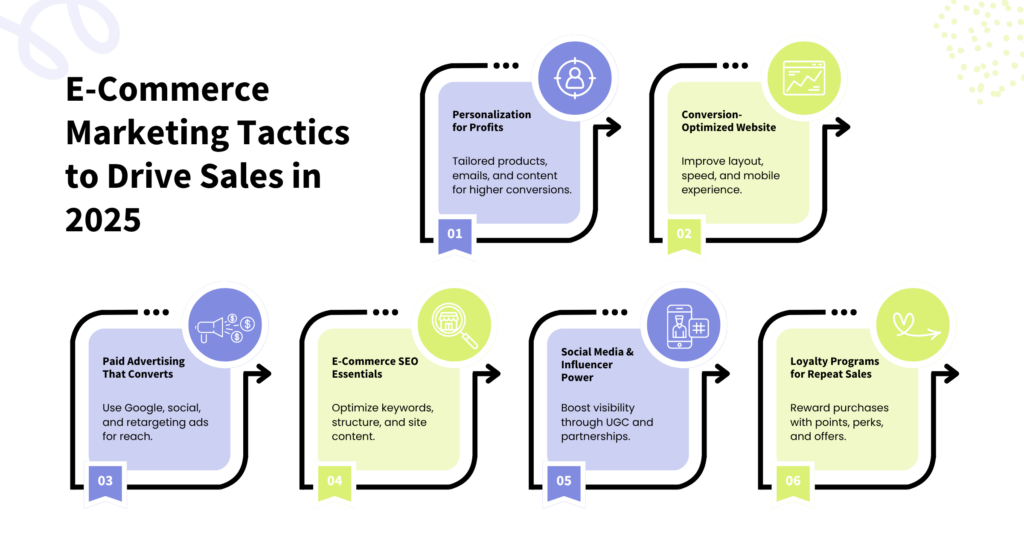Success in online retail takes more than great products. You need smart, data-driven e-commerce marketing strategies that attract traffic, convert visitors, and grow your revenue.
As competition rises, it’s not enough to simply be online. You need the right blend of SEO, paid ads, email marketing, and social media to stand out. Whether you’re launching a new store or scaling an existing one, the Strategic Digital Marketing Services can give you a serious edge.
In this guide, we’ll cover practical tactics that help increase sales and build long-term customer loyalty. Let’s explore what it takes to grow your e-commerce business through powerful, results-driven marketing.

Personalization: Tailoring the Experience to Boost Sales
When it comes to increasing e-commerce sales, personalization is paramount. Consumers today want to feel like they’re getting something uniquely tailored to them. According to studies, personalized shopping experiences can increase e-commerce revenue by up to 20%.
Why Personalization Works:
Consumers are more likely to purchase from a store that anticipates their needs. Personalized content, product recommendations, and tailored promotions make customers feel valued, encouraging repeat purchases.
Personalization Tactics to Implement:
- Product Recommendations: Use AI-powered tools to suggest products based on past purchases or browsing behavior.
- Personalized Emails: Send customers personalized email campaigns, offering product suggestions, discounts, or reminders about abandoned carts.
- Custom Content: Tailor website content to reflect customer preferences, making the shopping experience more engaging.
By focusing on personalization, you’re more likely to turn casual visitors into loyal buyers, thus increasing sales on your e-commerce site.
Optimize Your Website for Conversions
No matter how many marketing campaigns you run, if your website isn’t optimized for conversions, you’re leaving money on the table. Website optimization is one of the most important factors in increasing e-commerce revenue.
Key Areas to Focus On:
- Product Pages: Your product pages are your store’s storefront. Make sure they include high-quality images, compelling product descriptions, and easy-to-navigate layouts.
- Checkout Process: Simplify your checkout process. A complicated checkout experience is one of the main reasons for abandoned carts. Offering a guest checkout option can also help streamline the process.
- Site Speed and Mobile Optimization: Ensure your website loads quickly and is mobile-friendly. A slow site is a huge deterrent for potential customers, and with the rise of mobile commerce, optimizing for mobile is a must.
By fine-tuning these elements, you’re not just improving the user experience you’re actively boosting your chances to increase e-commerce sales.
Leverage Paid Advertising for Quick Wins
While SEO is essential, paid advertising provides immediate traction.
Whether you’re promoting a new product or scaling up seasonal campaigns, platforms like Google, Facebook, and Instagram offer unparalleled targeting.
Winning Paid Ad Strategies
- Google Shopping Ads
These show up directly in search results and let shoppers compare prices instantly. Perfect for intent-based conversions. - Social Media Ads
Use Facebook Ads to target users based on age, location, interests, and even shopping behaviors. Instagram and TikTok are ideal for visual brands. - Retargeting Campaigns
Bring back window shoppers with display ads reminding them of what they left behind. These campaigns have some of the highest ROI in e-commerce.
Paid ads help you scale fast, test what converts, and get products in front of the right people right when they’re ready to buy.
Implement SEO to Drive Organic Traffic
SEO (Search Engine Optimization) is a long-term strategy that is essential for any e-commerce site aiming to increase sales without relying on paid ads. By ranking high in search engine results, you can attract organic traffic that converts into paying customers.
SEO Strategies for E-commerce:
- On-Page SEO: Ensure each product page is optimized for relevant keywords such as “increase e-commerce sales”, “how to increase sales on e-commerce site”, and “increase e-commerce revenue”. This will help your products appear in relevant searches.
- Content Marketing: Use blogs, FAQs, and educational content to boost SEO. These pages can rank for long-tail keywords and drive additional traffic to your store.
- Site Architecture: Organize your site in a way that is SEO-friendly. Use clear URL structures, proper header tags, and internal linking to make it easier for search engines to crawl your pages.
With a solid SEO strategy in place, your site will not only attract more traffic but also convert that traffic into loyal customers, resulting in an increase in e-commerce revenue over time.
Social Media &Influencer Marketing: Connecting with Your Audience
The role of social media in driving e-commerce sales cannot be overstated. Platforms like Instagram, Facebook, and TikTok have become major players in the e-commerce space, providing businesses with a powerful tool to connect with their audience and showcase their products.
How Social Media Drives Sales:
- Shoppable Posts: Platforms like Instagram and Facebook allow you to add product tags directly to your posts, enabling users to buy with a simple click.
- Influencer Collaborations: Partnering with influencers in your niche can give your brand credibility and expose it to a wider audience.
- User-Generated Content (UGC): Encourage your customers to share photos of themselves using your products. UGC provides social proof and can increase trust in your brand.
By strategically utilizing social media and influencer marketing, you can significantly increase sales and expand your brand’s reach.
Customer Loyalty Programs: Building a Repeat Customer Base
While attracting new customers is important, retaining existing ones is equally crucial. Customer loyalty programs are a great way to ensure that your existing customers keep coming back, thus increasing e-commerce revenue over time.
How to Implement Loyalty Programs:
- Points and Rewards: Reward customers with points for every purchase they make, which can be redeemed for discounts or free products.
- Exclusive Offers: Provide loyal customers with exclusive deals, early access to sales, or birthday discounts to make them feel valued.
- Referral Programs: Encourage customers to refer friends and family by offering them incentives like discounts or free products.
Loyal customers not only generate repeat sales, but they also act as brand ambassadors, recommending your store to others and helping you expand your customer base.
Abandoned Cart Recovery: Bringing Back Lost Sales
Cart abandonment is one of the biggest challenges in e-commerce. According to recent data, nearly 70% of online shoppers abandon their carts before completing a purchase. However, by implementing a cart recovery strategy, you can recover a significant portion of these lost sales.
Effective Cart Recovery Tactics:
- Email Reminders: Send follow-up emails reminding customers about their abandoned cart. You can even offer a discount or free shipping as an incentive to complete the purchase.
- Exit-Intent Popups: Trigger popups when a user is about to leave the site to offer them a discount or free shipping, encouraging them to stay and complete the purchase.
- Retargeting Ads: Use retargeting ads to show the abandoned products to the customer on other platforms, nudging them to return and finalize their order.
By effectively managing cart abandonment, you can recover lost sales and increase e-commerce revenue.
Unlocking the Full Potential of Your E-commerce Store
E-commerce is competitive but the brands that win are the ones that out-strategize, not just outspend.
When you combine personalized experiences, conversion-optimized design, SEO, targeted ads, and consistent customer engagement, you’re setting your store up for real, measurable growth.
Every tactic in this guide is designed to help you increase e-commerce sales not in theory, but in practice.
At Riithink, we develop strategic roadmap for your eCommerce needs. From multichannel campaigns to performance-focused execution, we’ll help you scale smarter and build lasting success.







